Unsure about your French table manners? Click Here to download > > How to avoid these 10 food etiquette mistakes !
- Home ›
- Destinations ›
- Loire Valley ›
- Chinon Castle
Chinon Castle: Tales Of Heresy, Betrayal, And Liberation
Published 17 December 2024 by Leyla Alyanak — Parisian by birth, Lyonnaise by adoption, historian by passion
Henry II Plantagenet. The Knights Templar. Joan of Arc. Imagine a place they have all trodden, at different times during the Middle Ages: that would be Chinon Castle, in the Loire Valley. On a recent visit, I explored this mass of deep dungeons, vast rooms and crumbling walls to uncover some of the extraordinary stories behind it.
When you first see the Royal Fortress of Chinon in the distance, it stretches in a strategic position along a rocky ridge above the River Vienne, a jumble of pale limestone that seems to grow right out of the cliffs it crowns. For nearly a thousand years, its towers and walls have dominated the valley.
Now a historic monument, this is where Henry II faced rebellion and died in despair. It is where the last leaders of the Knights Templar were interrogated and imprisoned. And it is where Joan of Arc met the future Charles VII and set France on the path to victory.
If I were making a movie about Chinon, it would deal with ambition, defiance, and tragedy.
NOTE: Pages on this site may contain affiliate links, which support this site. See full Privacy Policy here.
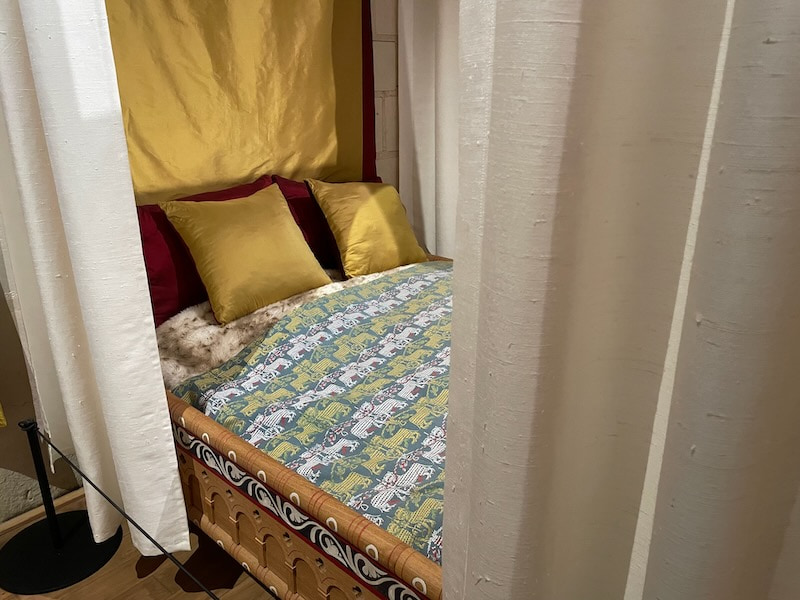 Reproduction of the bedroom shared by Henry II and Eleanor of Aquitaine at Chinon ©OffbeatFrance
Reproduction of the bedroom shared by Henry II and Eleanor of Aquitaine at Chinon ©OffbeatFranceBuilt as a strategic stronghold in the 10th century and expanded under Henry II, king of England, Chinon Castle became a royal residence, a prison, and the setting for some of Europe’s most defining moments.
Today, part of the site of the fortress has been restored, while other sections remain crumbling. Interestingly, new remains and artefacts are still being discovered.
A lot of things happened at Chinon over the years, but the more memorable ones dealt with major characters in the history of France, and of Europe.
Here are three of the best known.
The King who was betrayed by his sons
Medieval stories of betrayal aren’t exactly rare, so finding a massive one at Chinon Fortress is no surprise.
I’m talking about a descendant of William the Conqueror, King Henry II Plantagenet, and his sons.
It all started with Eleanor of Aquitaine, one of the the most influential women of the 12th century, who would rule as queen of both France and England.
Her first marriage to Louis VII of France didn’t work out and produced no male heir. By pleading consanguinity, they were able to annul their marriage. This put Eleanor back in charge of her native Aquitaine, single again, and a great catch.
None of this escaped Henry II, then Duke of Normandy and Count of Anjou. He saw the benefits of acquiring Aquitaine, pursued Eleanor and won her, resulting in the unification of their extensive territories, stretching from Scotland to the Pyrenees.
They had eight children together but the marriage ran into trouble, what with Eleanor’s strong will and Henry’s infidelities. Petty jealousies and desire for more power prompted several of his sons to rebel, but when Eleanor sided with them, he threw her in jail.
Henry had been using Chinon as his main residence in France and to to run his state and military affairs. He would find refuge here as his sons rebelled, and would die here in 1189.
It wasn’t exactly the most cheerful place, and must have been austere even for the times. But it was a mighty structure, one that spoke volumes about the king’s power and authority.
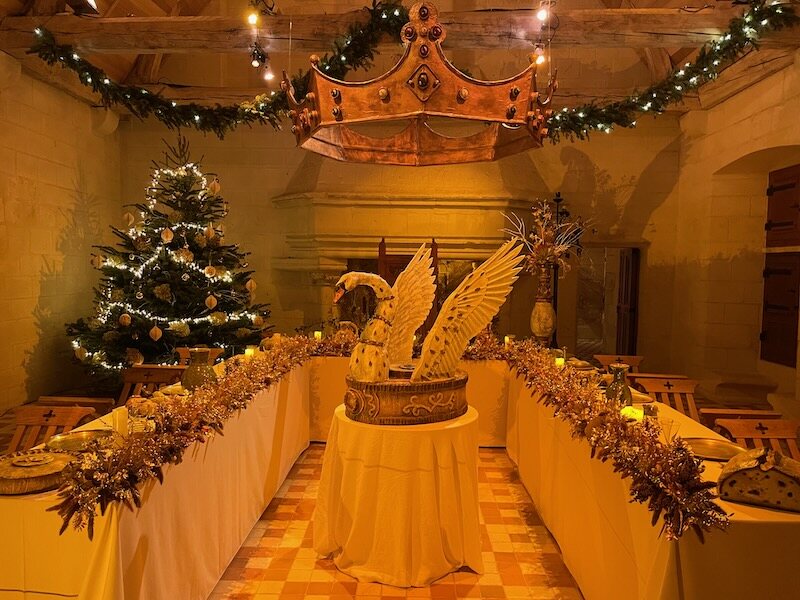 A Christmas banquet table designed by Coach Floral, as it would have been set in Eleanor of Aquitaine’s time ©OffbeatFrance
A Christmas banquet table designed by Coach Floral, as it would have been set in Eleanor of Aquitaine’s time ©OffbeatFranceThe betrayal by his sons and his death have yielded all sorts of conspiracy theories and ghost stories, for example, that Henry’s restless spirit roams among the fortress’s ancient stones, mourning his sons’ treachery.
Modern views of King Henry and Eleanor of Aquitaine
- “The Lion in Winter”, a 1966 play by James Goldman about Christmas 1183 at Chinon Castle for Henry, Eleanor and their three sons
- The play was adapted into a 1968 film starring Peter O’Toole and Katharine Hepburn in high-stakes maneuverings for power (Hepburn won an Academy Award for Best Actress)
- A 2003 TV adaptation featuring Patrick Stewart and Glenn Close as Eleanor introduced the story to a new generation of viewers.
- Plantagenet Princes, a book by Douglas Boyd, traces the lives of Henry's and Eleanor's sons
Today, vestiges of the Plantagenet era continue to be uncovered by archaeological excavations and who knows what may still be found along the castle walls or yet another restoration project.
The Château du Milieu (Middle Castle) contains the restored south wing of the royal quarters, where the Plantagenet court once convened. And you’ll have to pass under the 14th-century Tour de l’Horloge (Clock Tower) to reach the Chateau du Milieu...
The last prison of the Knights Templar
In 1308, Chinon became a prison for five most unusual guests: the highest-ranking Knights Templar, including Grand Master Jacques de Molay, were held in Coudray Tower for several months.
They were awaiting trial for heresy in Paris, at a time when the Inquisition was in full swing. But the truth of the Templars' demise is perhaps more mundane: Philip IV, King of France was jealous of the Templars' power and deep in debt to them, but rather than repay them, he chose to disband the entire Order, seizing their assets and wiping his slate clean.
This would signal the abrupt end to an order that to this day remains surrounded by mystique.
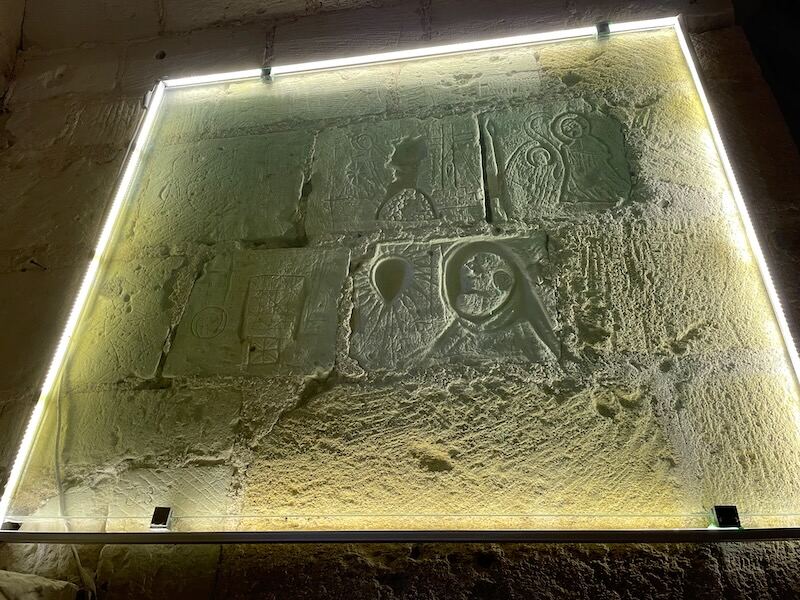 These are faithful reproductions of the graffiti left in the tower by the Templars − crosses, symbolic shields and cryptic messages that may reflect their faith, despair, or , who knows, perhaps secret codes? ©OffbeatFrance
These are faithful reproductions of the graffiti left in the tower by the Templars − crosses, symbolic shields and cryptic messages that may reflect their faith, despair, or , who knows, perhaps secret codes? ©OffbeatFrance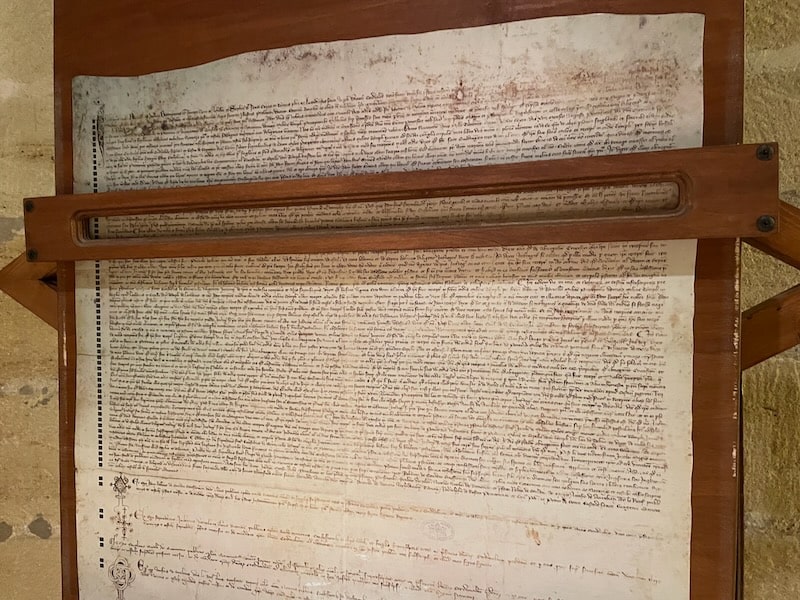 Fragment of the Chinon Parchment on display at Chinon Fortress. The historic document sheds light on their final days and their secret dealings with Pope Clement V.
Fragment of the Chinon Parchment on display at Chinon Fortress. The historic document sheds light on their final days and their secret dealings with Pope Clement V.Initially, Pope Clement V had intended to question the Templar leaders himself in Poitiers, but their ill health made travel impossible so the Pope sent down three cardinals to Chinon instead.
The Templars would be held in the tower’s subterranean chambers, hewn directly into the bedrock, whose damp and oppressive atmosphere would give way to legends that continue to intrigue us today.
Once transferred to Paris, Grand Master Jacques de Molay faced execution by burning in 1314. As the flames consumed him, he is said to have cursed both the French king and Pope Clement V, summoning them to join him in divine judgment within a year.
Both men would die before the year was out. Coincidence, or divine retribution?
Chinon’s aura is further enhanced by persistent rumors of hidden Templar treasures (there are dozens of rumors of Templar treasures concealed across Europe). Since the Order was extremely wealthy, the sudden arrest of the Knights Templar led to speculation about secret caches of riches. No treasure has been found, but the rumors contribute to the fortress’s mystique.
THE KNIGHTS TEMPLAR
The Knights Templar, officially known as the Poor Fellow-Soldiers of Christ and of the Temple of Solomon, were an elite medieval Christian military order founded in Jerusalem around 1119 to protect pilgrims traveling to the Holy Land during the Crusades.
Predominantly French at first, the order quickly expanded across Europe, with members from England, Portugal, Scotland and beyond − a truly multinational force. Recognizable by their distinctive white manteaus adorned with a red cross, they became one of the most prominent and wealthiest military orders in Western Christianity, part religious devotion and part military prowess.
In a remarkable twist to the story, something known as the Chinon Parchment was discovered in 2001 in the Vatican’s secret archives. A document from 1208, it reveals that Pope Clement V had actually absolved the Knights Templar of heresy. The parchment indicates that while the Templars confessed to certain charges under duress, they were absolved of heresy. This was kept secret, possibly due to pressure from the King, fully determined to destroy the Order and seize its wealth.
This finding complicates the narrative of the Templars' downfall, suggesting it was driven more by Philip’s greed than genuine accusations of heresy. It also casts a shadow over Clement V’s role, portraying him as a reluctant pawn in the King’s political maneuvering.
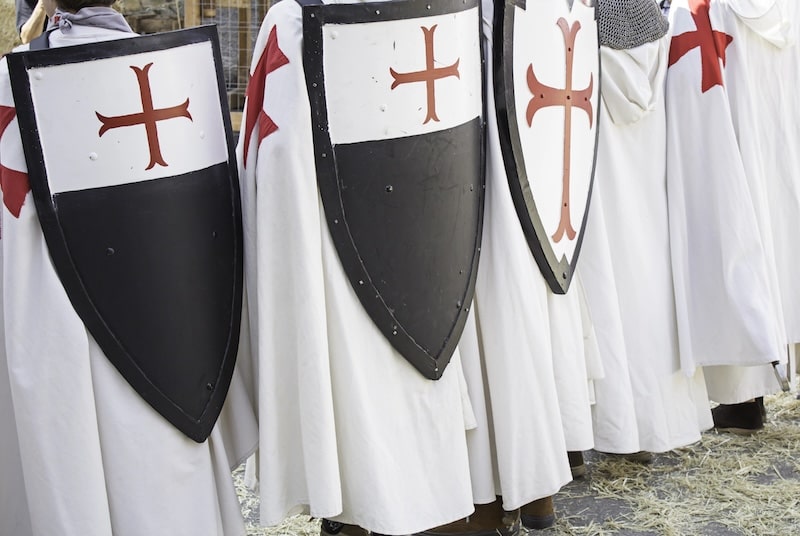 Typical clothes and accoutrements of the Knights Templar, adorned with their characteristic red cross, associated with the Crusades
Typical clothes and accoutrements of the Knights Templar, adorned with their characteristic red cross, associated with the CrusadesWhen Joan of Arc got her army
Most of us are familiar with the beginnings of Joan of Arc’s saga in the 15th century.
As a teenager, in a famous episode she claimed to hear divine voices urging her to save France from the English fighting the Hundred Years’ War. Despite her relatively humble origins, she convinced local officials and nobles to support her journey, crossing enemy lines to Chinon in 1429 to seek an audience with the uncrowned Dauphin, Charles VII (much of France was under English rule at the time).
The chateau of Chinon was no ordinary stop − it was Charles’ stronghold, a refuge as his claim to the throne hung by a thread.
Surrounded by skeptical advisers, the Dauphin hesitated but finally agreed to see the girl who claimed to be sent by God. It is said that Joan made her case by correctly identifying Charles, even though he tried to trick her by posing as someone else.
Lucky guess or divine vision? Doesn’t matter. The moment cemented her reputation as someone who was "divinely" inspired.
What followed was nothing short of extraordinary. Joan convinced Charles to give her an army, with which she liberated Orléans, changing the tide of the war, chasing out the English, culminating in Charles VII’s coronation at Reims (although sadly, it didn’t end too well for Joan).
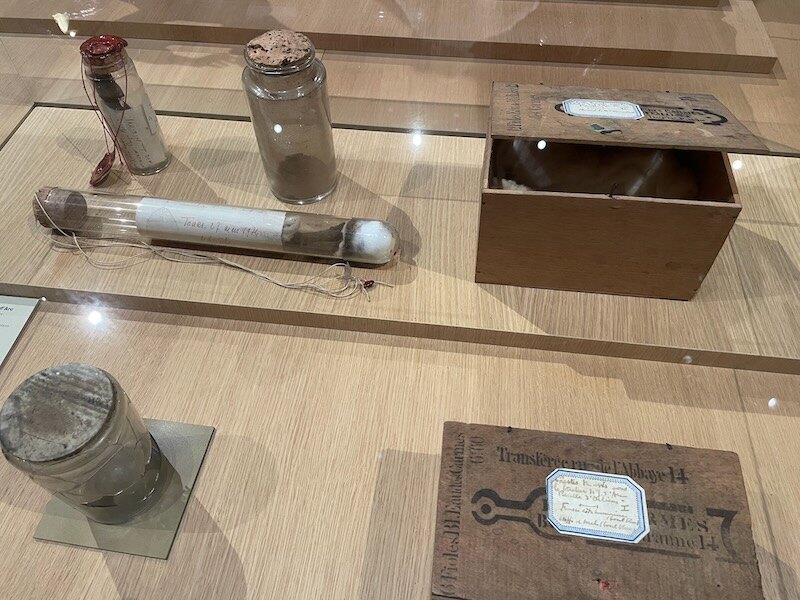 This tapestry hangs in Chinon Fortress and depicts a kneeling Joan of Arc asking the Dauphin for an army to conquer Orléans ©OffbeatFrance
This tapestry hangs in Chinon Fortress and depicts a kneeling Joan of Arc asking the Dauphin for an army to conquer Orléans ©OffbeatFranceThe room in which this historic meeting took place no longer exists, but we know exactly where it stood.
In the central part of the fortress, in the Château du Milieu, you can see what is left of the grand fireplace that once warmed the room. You may not be able to walk in Joan’s footsteps, but you can certainly connect with her story here.
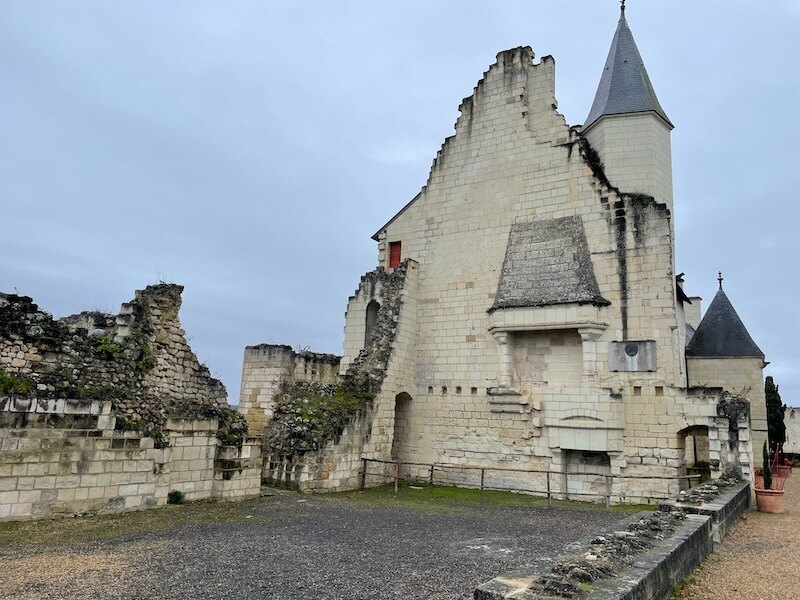 Not much is left of the room in which Joan of Arc met the future Charles VII − except the outline of a fireplace on the wall ©ffbeatFrance
Not much is left of the room in which Joan of Arc met the future Charles VII − except the outline of a fireplace on the wall ©ffbeatFranceThe room where Joan of Arc met Charles VII at Chinon would have been grand yet austere, reflecting the fortress’s dual residential and strategic role.
It would have featured high stone walls, tapestries for insulation and decoration, and of course, massive fireplaces with which to ward off the chill. Lights from fire and torches would have flickered, casting long shadows to heighten the drama of the moment.
What matters is that Joan’s entreaty worked, and had it not been for her plea for battle from the Dauphin at Chinon, the course of the Hundred Years’ War (and Europe's history) might well have been different.
Rarely a year goes by without some rumor or legend or fact unearthed about Joan of Arc; everyone has an opinion about her, and her life is far enough in the past that separating fact from fiction can be a challenge.
Take the “Joan of Arc jars”... Apparently they were bought by an association a few years ago and placed in the Clock Tower, with a label stating they were remains recovered from Joan of Arc’s funeral pyre. Carbon-14 dating revealed the remains to be... Egyptian and cat mummy dust.
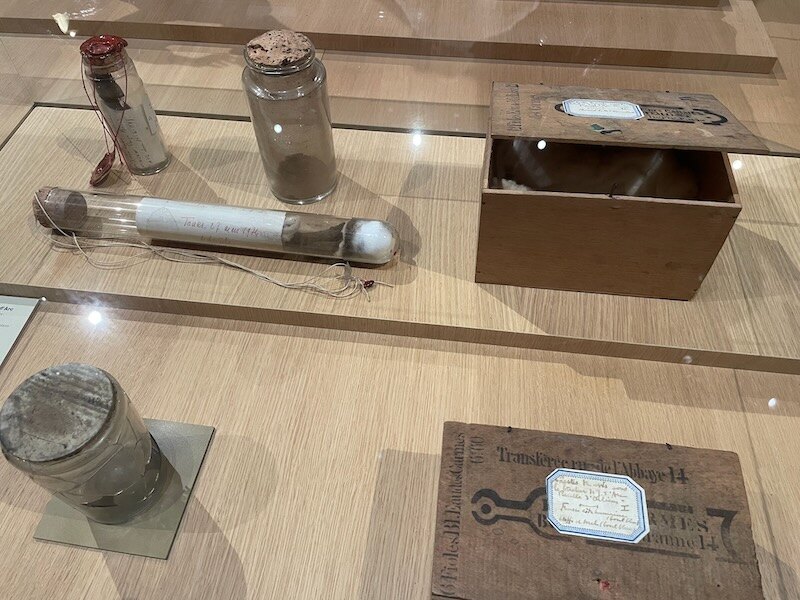 The small jars were once thought to contain remains of Joan of Arc taken from her funeral pyre ©OffbeatFrance
The small jars were once thought to contain remains of Joan of Arc taken from her funeral pyre ©OffbeatFranceSo much for the jars. But Chinon kept them. Just in case.
Tips for visiting Chinon Castle
Chinon is actually three castles in one, but you'll have a better sense of its layout on their website or by using the "histopad" tablet you can get at the entrance.
Highlights of the Chateau de Chinon
Here's what not to miss:
- Tour de l’Horloge (Clock Tower): Begin your visit here at Chinon’s iconic entrance. Climb to the top for sweeping views of the Vienne Valley.
- Tour du Coudray: Visit the eerie chambers where Knights Templar leaders were imprisoned..
- Royal apartments or lodgings: Step into the area where Joan of Arc met Charles VII. Look for the remnants of the grand fireplace marking the site of this historic encounter.
- The oldest section: Venture to the farthest point of the fortress to discover time-worn walls, grassy moats, and overgrown courtyards.
- Middle courtyard: A tranquil, green-framed space to reflect on Chinon’s rich history.
FASCINATED BY FRENCH CASTLES?
- How Two Remarkable Women Fought Over Chenonceau Castle (and who won)
- 4 Chateaux of Loire valley and their conspiracy theories, lust and secrets
- Chateau Bussy Rabutin And The Salacious Count Who Lived There
- 9 Things To Know Before Visiting Chateau De Cheverny
- Voltaire in Love: The Improbable Power Couple of the Chateau de Cirey
Getting to Chinon
Chinon Castle is one of the more easily accessed Loire Valley châteaux by public transport but not necessarily the closest. It is easily reached by car, a 45-minute drive from Tours or 2.5 hours from Paris.
It is also one of the few castles that can be reached by train, in less than an hour from Tours but a bit longer − with one or two connections to the small town of Chinon − from Paris Montparnasse.
Where to stay in Chinon
- Hôtel Diderot: classic, calm and comfortable, authentically French and perfectly located
- Best Western: beautifully restored 16th-century heritage building within walking distance of everything
- Hôtel Rive Sud, modern and quiet rooms.
Header image: ©Jean-Christophe COUTAND/Agence Départementale du Tourisme de Touraine

